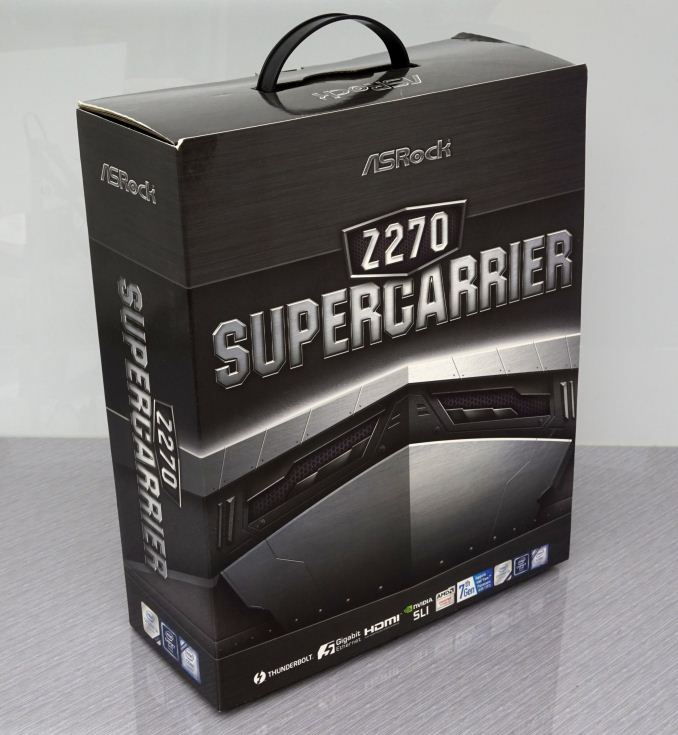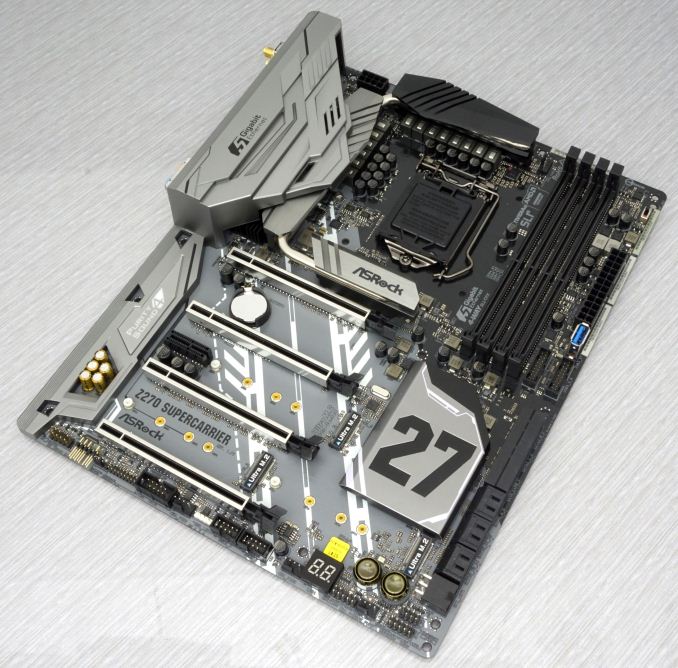The ASRock Z270 Supercarrier Motherboard Review: 4-way SLI and 5 Gigabit Ethernet on Kaby Lake
by E. Fylladitakis on September 29, 2017 9:00 AM EST- Posted in
- Motherboards
- ASRock
- SLI
- Aquantia
- Z270

Ever since Intel released the Z270 chipset earlier this year, we reviewed several motherboards based on it, ranging from the low-cost Mini ITX ECS Z270H4-I Durathon 2 to the advanced gaming motherboards from Asus and GIGABYTE. As literally dozens of Z270-based motherboards were released, we could not possibly review them all and we centered our choices on products that we believed to be of interest to the largest portion of our readers. However, someone could argue that even though the top-tier market is relatively small, it also consists of the most knowledgeable and demanding users, who cannot fulfill their wants and needs with a mainstream motherboard.
In this review, we are having a look at the ASRock Z270 Supercarrier, a top-tier motherboard designed for professional designers and elitist gamers. Despite its typical ATX dimensions, the Z270 Supercarrier is loaded to the hilt, with a tremendous number of connectors and several features that cannot be found on mainstream motherboards. While the price tag will drive every casual/mainstream user away instantly, the Z270 Supercarrier is one of the few choices with a LGA1151 CPU socket available for professional designers and gamers who are not satisfied with one or two GPUs.
The ASRock Z270 Supercarrier Overview
A simple glance at the list of this motherboard’s features is likely to leave most people in awe. If we were to single out the highlights of the Z270 Supercarrier, these would be the 14-phase CPU power circuitry, the four PCIe ×8 slots for full-size graphics cards and the AQUANTIA 5 Gbps network controller, all of which are features that cannot be found on mainstream motherboards. The number of supported storage devices is immense, with three PCIe ×4 M.2 slots, six SATA connectors and two SATA Express connectors. Each SATA connector may also be used as two standard SATA ports, bringing the maximum number of regular SATA devices up to 10 if no SATA Express devices are installed. There are no U.2 connectors and this is one of the very few features that the Z270 Supercarrier is lacking. This problem can be easily tackled with the use of proper M.2 to U.2 adapters.
The ASRock Z270 Supercarrier also has very interesting controllers installed. The “Purity Sound 4” onboard audio has a popular ALC1220 audio controller supplied by Realtek at its heart, supported by a Texas Instruments NE5532 headset amplifier and other hardware. It has not one, not two, but three different LAN controllers. The first is the Aquantia AQC108 5 Gbps controller, which is one of the highlights of this motherboard. Intel supplies the other two Gigabit controllers (I219V and I211AT), as well as the wireless LAN module (AC3160). We also found several controllers from ASMedia on the Z270 Supercarrier for additional USB, SATA, and Thunderbolt ports.
In summary, the ASRock Z270 Supercarrier is a motherboard primarily designed to entice professional designers, users who usually are seeking to build 3-way and 4-way SLI systems with a lot of storage devices. That is a very limited segment of the market and ASRock’s engineers are clearly trying to expand it by adding features that would also tempt gamers and overclockers with very large budgets. Even in its default configuration, the ASRock Z270 Supercarrier manages to outperform every other Z270-based motherboard that we have tested to this date, while it also displayed very promising overclocking capabilities during our testing. At this point we should mention that the higher overall performance does not come from any magic tricks but, as we found out during our testing, by ASRock’s engineers “cheating” and setting the CPU’s Turbo multiplier at 45 by default, allowing a 7700K processor to reach 4.5 GHz without tweaking any BIOS settings or other options.
Quick Board Feature Comparison
| Motherboard Comparison | ||
| ASRock Z270 Supercarrier | ||
| Socket | LGA1151 | LGA1151 |
| MSRP at Review | $349 | $140 |
| DRAM | 4 x DDR4 | 4 x DDR4 |
| PCIe Layout | ×8/×8/×8/×8 | x8/x8 |
| BIOS Version Tested | 1.11 | 2.00 |
| MCT Enabled Automatically? | No | Yes |
| USB 3.1 (10 Gbps) | Intel JHL6540 | None |
| M.2 Slots | 3 x PCIe 3.0 x4 | 2 x PCIe 3.0 x4 |
| U.2 Ports | No | No |
| Network Controller | 1× AQC218 / 1 x Intel I219-V / 1 x Intel I211-AT | 1 x Intel I219-V |
| Audio Controller | Realtek ALC1220 | Realtek ALC892 |
| HDMI 2.0 | No | No |
Other AnandTech Reviews for Intel’s 7th Generation CPUs and 200-Series Motherboards
($110) The ECS Z270H4-I Durathon 2 Review
($140) The ASRock Z270 Killer SLI Review
($140) The MSI Z270 SLI PLUS Review
($159) The ASRock Z270 Gaming-ITX/AC Review
($170) The Asus Prime Z270-A
($170) The GIGABYTE Z270X-Ultra Gaming
The Intel Core i7-7700K (91W) Review - CPU Review
The Intel Core i5-7600K (91W) Review - CPU Review
The Intel Core i3-7350K (60W) Review - CPU Review
Our Latest Best CPU Recommendations
In comparison to the older Z170 boards, the new Z270 board on the base specifications are hardly any different. The Z270 ones have four extra PCIe lanes configurable on the chipset, potentially new audio and new networking controllers, and Intel Optane Technology Support. Although four extra PCIe lanes do sound like a huge difference, it is an important upgrade for the implementation of native M.2 slots (on Z170-based motherboards, this usually meant disabling some other device/port on the motherboard). Also, note that Intel Optane drives should still function on other chipsets as drives; the Z270 only allows them to enable their “smart caching” technology.
The Intel Optane Memory (SSD) Preview: 32GB of Kaby Lake Caching
Individual motherboard manufacturers will be sprinkling on new features onto their Z270 products to aid the transition and provide other tangible benefits over the old platform. To read specifically about the Z170 chip/platform and the specifications therein, our deep dive into what it is can be found at this link.
A Small Note on USB Naming
One thing that we should note is that the advent of the Z270 chipset brought a change on the naming of the USB ports. What we knew as USB 3.0 ports are now being dubbed as “USB 3.1 Gen 1” and the 10Gbps ports are now called “USB 3.1 Gen 2”. We first encountered this change while reviewing the MSI Z270 SLI Plus a few months ago but it seems that most of the manufacturers are following suit, rewriting their websites and reprinting their manuals. Users need to be extra careful when very high bandwidth connectors are essential.












50 Comments
View All Comments
wiyosaya - Friday, September 29, 2017 - link
I am confused! 4-way SLI? Am I living in a time bubble or something? I thought that nVidia announced some time ago that they were focusing on 2-way SLI due to scaling issues and that support for 4-way SLI would be minimal in the future.Besides, with 4-lane pci-e on this thingy, if anyone really wanted to do 4-way SLI, it seems like Threadripper (or sIntel's equivalent enthusiast parts) would be a much better platform for 4-way SLI.
Maybe ASRock is just trying to prolong the wave artificially.
MadAd - Friday, September 29, 2017 - link
there are other niche uses for 4 way, a hobbyist mining rig, a small render farm for blender, or the well off who just want to throw money at making a stonking pcBrokenCrayons - Friday, September 29, 2017 - link
Typical GPU mining on a large scale can work with a 1x PCIe slot so four 16x slots aren't really of any added value for that sort of situation.Notmyusualid - Friday, September 29, 2017 - link
4x SLI on Pascal works. I have 4x 1070 FTWs in my main rig. Search it out on a well-known video site.Due to installed PCIe switches, all four of my GPUs 'see' a x16 3.0 slot each, but they are multiplexed together to share 40 available lanes from the CPU, and this seems more than plenty, so I shake my head to comments fighting over how many lanes you have over this amount, because this works just fine. *Maybe* 28 would be too few, but 40 is just fine. Depends on what you are doing I suppose.
I won't be buying Threadripper due to what I see as confusion over different modes of operation, and possible latency issues (depending on application), and the multiple internal dies. Back in the day, it amused me to see people poking fun at the 'Core 2 Quads' for not being 'real' quad cores, but nobody I have seen has mentioned that TR is not just two - but FOUR separate dies on the same package, whilst the competition - Intel, has all its cores on a single die / package this time around (as far as I know).
I'm slightly impressed with TR, but not enough to buy it, given I already have 14c/28t Xeon.
supdawgwtfd - Sunday, October 1, 2017 - link
TR is 2 dies.The other 2 dies are just there to help support the IHS.
Perhaps if you weren't completely ignorant you would know this. And saying TR is confusing compared to Intel is a laugh.
Had a look at Intel's X299 line up at all?
Noticed that they have many different CPUs all with different pcie lanes?
Now THAT is confusing.
Notmyusualid - Sunday, October 8, 2017 - link
Well stone me. 2 / 4 dies? It still leaves the opportunity for increased latency, as some sites have mentioned. So my comment stands.But yes, recent Intel confusion with socket / chipset compatibility leaves much to be desired. No way I'm going to defend that. But you'll know when you build your Intel rig, core-core latencies will be lower.
rocky12345 - Friday, September 29, 2017 - link
Great review as always thanks.It seems weird that the MB makers are releasing so many z270 boards when it is basically at the end of life even before a year is up from when it was released. I guess Intel caught the MB makers off guard here as well and they are stumbling fast to get these boards out ASAP because of the R&D it cost to design them.
timecop1818 - Saturday, September 30, 2017 - link
This board was released months ago (like April 2017 or earlier), they just got around to reviewing itrpjkw11 - Friday, September 29, 2017 - link
I really like the three M.2 connectors. I have no need, yet, for U.2, but I long ago ditched HDDs and now run two SSDs.rsandru - Friday, September 29, 2017 - link
The NE5532 is an op-amp and not a headset amplifier.It's been first released in 1985 and has been found in all kinds of electronics since then because it's cheap. I'm struggling to find a reason why it's mentioned as some sort of feature...